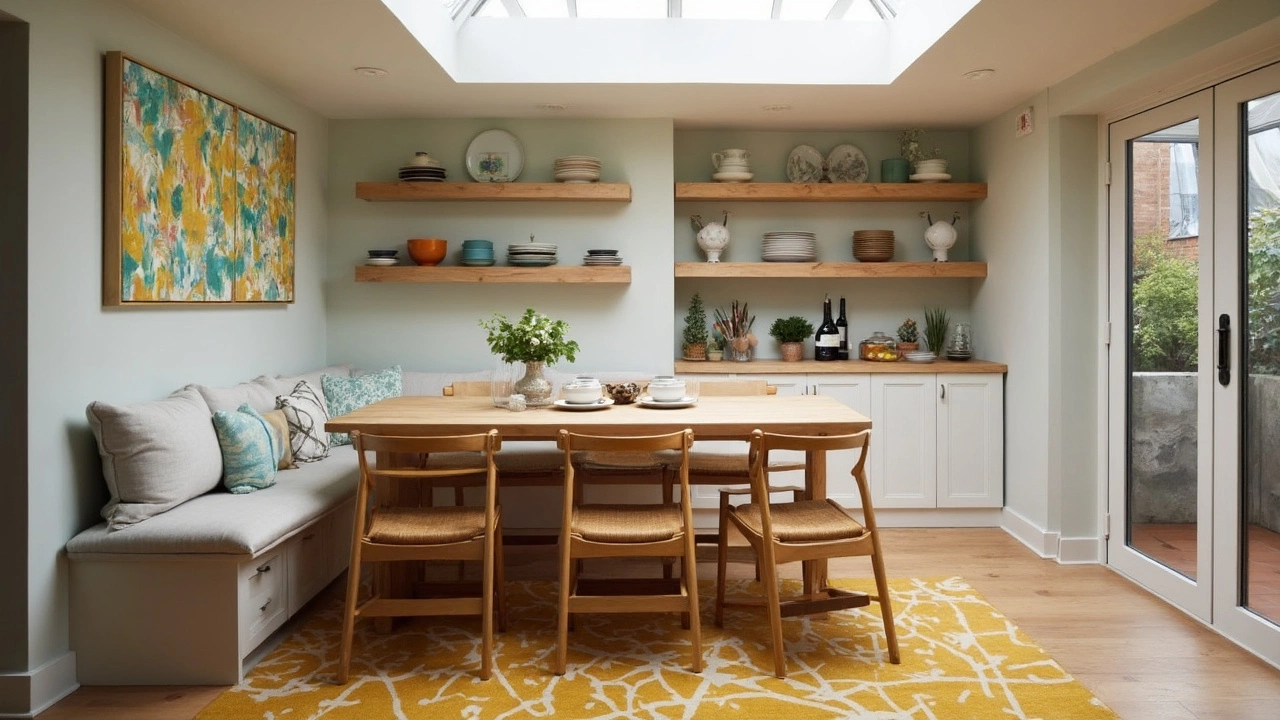If you've ever squeezed around a bulky dining table or wondered why your dining room feels like a cave after sunset, you're not alone. Most people just want their space to look bigger and brighter, not like a fancy showroom or a Pinterest fantasy. And honestly, you don't need a complete remodel to make real changes. The right table, clever use of color, and a few smart swaps can give your dining room a fresh, open vibe.
First off, let's talk furniture. That beautiful farmhouse table with chunky legs looks cool—but if your chairs hardly slide out, you'll end up frustrated every mealtime. Go for slimline tables and benches instead of big, heavy chairs. Glass or acrylic tables are sneaky heroes: they almost disappear, letting light move freely around the space. Using fewer, lighter chairs instead of a bunch of bulky ones leaves more wiggle room, literally and visually.
- Choose Furniture That Works With Your Space
- Let There Be (Natural) Light
- Color, Mirrors, and Visual Tricks
- Declutter and Keep It Simple
Choose Furniture That Works With Your Space
Trying to make a small dining room feel bigger? It all starts with the type of dining room furniture you pick. Big pieces make your room feel crowded, so it pays to go lighter and smaller wherever you can.
Think of tables with simple lines and thinner legs. Round or oval tables are a lifesaver—you don’t have those harsh corners stealing walking space. And if you barely ever host a big group, skip the giant table. Size down to what you actually use most of the time. You can always pull out a folding table for holidays.
Benches are another secret weapon. You can tuck a bench under the table when it’s not in use, freeing up space around the room. And if you need real proof, IKEA’s research found that flexible seating arrangements, like benches and stackable chairs, can open up to 15% more usable floor space in small rooms.
If you just can’t give up cushy upholstered chairs, limit them to the ends of the table for a “host and hostess” setup. Keep the other seats slim and simple. Storage benches or banquettes are a win too: they add seating and give you sneaky spots to stash stuff like off-season table cloths.
Furniture on legs (instead of closed bases) lets more floor show, making the room seem less cramped. Glass tables and clear acrylic chairs almost vanish in a small space, letting light bounce around. According to designer Emily Henderson, “Glass or see-through furniture doesn’t visually block the room, so even a tight space feels more open.”
“Most people overestimate how much dining furniture they need. Start with the basics, see what fits, and only add what you really use.” — Nate Berkus, interior designer
Last tip: skip oversized buffets or cabinets, especially super dark wood ones. If you need storage, go with floating shelves or something lean. The more open area you see, the bigger and brighter everything feels. The right choices keep your dining setup functional and give the whole room space to breathe.
Let There Be (Natural) Light
If your dining room feels like a cave, the first step is to take a good look at your windows. Natural sunlight does wonders for making a dining room look bigger and more welcoming—no magic required! Start by clearing bulky drapes or heavy blinds. Swap them for sheer curtains or leave windows bare if privacy isn't a problem.
Most people forget that furniture placement matters here. Don't block your windows with tall shelves, hutches, or even big plants. Low-back chairs and glass-topped surfaces help bounce light around, making the whole space feel more open.
- Hang a mirror across from your window. This is one of the oldest designer tricks—mirrors reflect natural light and double how bright your room feels, especially when the sun hits just right.
- If your windows are small, keep wall colors light—think whites or pale neutrals. Light colors reflect more sunlight than darker ones, instantly lifting the mood.
- Choose lighting that mimics daylight. Warm, soft bulbs can stop the room from going gloomy once the sun dips. Layer lighting with overheads, wall sconces, or even a simple floor lamp in the corner if your ceiling lights are weak.
As a fun fact, research from the Lighting Research Center shows that rooms with good daylight not only look bigger, but also improve mood and even help with focus. So, open those blinds as wide as they'll go and make the most of the windows you have.

Color, Mirrors, and Visual Tricks
If your dining room needs a boost in size and brightness, color is your secret weapon. Lighter shades like white, pale grey, soft blues, or even buttery yellows bounce light around and instantly make a room look bigger. Dark walls do the opposite—they swallow light and shrink everything. Painting the ceiling a shade lighter than the walls pulls eyes up and gives the illusion of more height, which is a fast win when you want the room to feel spacious.
Mirrors are another easy trick for a cramped dining area. When you hang a mirror opposite a window, it doubles the natural light, making everything seem sunnier and more open. Even a big mirror leaning against one wall works wonders, and it doesn’t have to cost a fortune—find something simple with a slim frame so it doesn’t look too heavy. Plus, the reflection of your dining room furniture adds depth, kind of like a room within a room.
- Go for rugs, curtains, and chair fabrics in light shades and small patterns. Heavy fabrics or loud patterns can make the room feel busy and boxed in.
- Vertical stripes, whether on wallpaper or curtains, pull the eyes up and help ceilings seem higher.
- If you love color, keep it to accents—maybe one bold vase or a bright chair—so the vibe stays open, not overwhelming.
Here's a neat fact: interior designers often use see-through accessories like glass lamps or acrylic trays to avoid clutter and keep things bright. Try this on your dining table or sideboard if you want the space to feel light and modern without being empty.
Declutter and Keep It Simple
Cramped, messy rooms always feel smaller, no matter how nice your dining room furniture is. One of the fastest ways to open up the space is by clearing surfaces—yes, even that pile of mail or all those decorative knick-knacks. Less is more here. Researchers at UCLA found that cluttered homes can actually raise stress levels, and you probably feel that when you look at an overstuffed dining area.
Start by removing anything you don't need for regular meals. Everyday stuff like salt and pepper shakers, napkins, or a simple centerpiece are enough. Skip the big candelabras or collections of vases. If you use the room for storage, invest in a slim storage piece with doors, like a credenza, to keep things out of sight.
Don’t forget your walls, either. If every inch is covered with artwork or shelves, your eye doesn't know where to land—it makes the room look cluttered even if the table is clear. Stick to one large piece of art or just a couple of small frames. It lets the walls "breathe" and helps the whole space feel calm.
Lastly, open up your floor. Rugs should fit under the table and chairs comfortably—too small, and the room feels chopped up. Don’t crowd the corners with baskets or plants unless there’s real breathing room. Space to move equals space to feel.
- Clear your table and surfaces, only keeping essentials out.
- Hide extra stuff in simple closed storage, not open shelves.
- Limit wall decorations to one big or two small pieces.
- Make sure rugs are big enough and corners aren’t crowded.
Once you get in the habit of keeping things simple, you'll notice your dining area already looks and feels way bigger and brighter, without spending much.
 EN
EN
 HR
HR
 AR
AR

